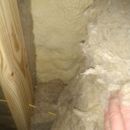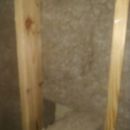Condensation issues with Flash and Batt
Hello all,
We are having a condensation issue with a new pole barn house build. After alot of research we decided on flash and batt. We are in zone 3 but only 60 miles from zone 4. Starting at the exterior working inward we have the exterior sheet metal, 1/2 of rigid foam, 2″ of spray foam then 8″ of unfaced rockwool, then a second 6″ stud wall that is empty for electrical, water lines etc. We do not have the exterior walls drywalled yet, we were just starting when we pulled back the rockwool to install the dryer vent and found condensation on the spray foam. The research we did beforehand, for our zone said this would work well. Our heating is 2 Hyperheat Mitsubishi units and we are going to install a Cerv2 shortly. Our heat is set on 62 in the house, humidity is at 56% and it has been between 20 and 40 degrees here lately. Also at this time our crawlspace isn’t insulated but is enclosed.
I’ve read everything from “you need more spray foam” to “just put up a vapor barrier before you drywall and it will be fine”.
Not sure which way to go.
Thank you for any help.
GBA Detail Library
A collection of one thousand construction details organized by climate and house part












Replies
The experts will chime in, but I suspect you have condensation because there is no air barrier. If you install the drywall in an airtight fashion and complete the conditioning of the crawlspace, you should be okay.
The spray foam is closed cell, correct?
Yessir, closed cell.
Thank you for responding.
Much appreciated.
We were thinking of renting an industrial dehumidifier to get rid of the condensation until we can get the vapor barrier and drywall up.
One way to determine how much foam vs. total insulation you need is to look at table R702.7.1 in the IRC:https://codes.iccsafe.org/content/IRC2015/chapter-7-wall-covering#IRC2015_Pt03_Ch07_SecR702.7. It gives prescriptive values assuming code-minimum R-values, but you can calculate the ratio of foam vs. total wall insulation and extrapolate to higher insulation values. In Climate zone 4 (marine), the table shows that you need a minimum of 16-17% of the total R-value to be in the foam. If you have less, the remaining insulation keeps indoor heat from reaching the foam so it gets cold enough to condense water vapor out of the air.
In your case, you have roughly R-14 between your rigid and spray foam layers and about R-30 in your mineral wool, or about R-44 total. That puts 32% of the R-value in the foam, so you should be well-covered there. So what's going on?
While not noted on the IRC chart, this documenthttps://www.buildingscience.com/sites/default/files/document/ba-1406_measure_guideline_incorporating_thick_layers_of_exterior_rigid_insulation_on_walls_2015-04.pdfsays that for those ratios to be safe they assume an interior temperature of 70°F and a relative humidity (RH) of no more than 35% in the coldest month--air with those values will condense on a surface about 42°F. You mentioned 62°F and 56% RH; air with those values will condense on a surface about 46°F. If you are using an inexpensive hygrometer it is likely calibrated for a temperature higher than 62°; 56%RH air at 68° will condense at about 52° RH.
使用上面的价值观中,我的数学说,当它s colder than about 34°F outside you could have condensation. (Or higher temperatures if the hygrometer is registered to 68°.) That's why it's important to have an interior air barrier; it doesn't need to be hermetically sealed, but it needs to slow air from circulating freely through your mineral wool. Although not required in your climate zone, you could also add interior vapor control to limit vapor diffusing through the drywall; standard latex paint is enough in this situation. But it should not be necessary in your location.
An EnergyStar rated dehumidifier from the big box store would probably be fine. On air and vapor barriers, here's a quote from one of Martin Holladay's articles:
"Most buildings don’t need polyethylene anywhere, except directly under a concrete slab or on a crawl space floor. The main reason to install an interior vapor retarder is to keep a building inspector happy. If a building inspector wants you to install a layer of interior polyethylene on a wall or ceiling, see if you can convince the inspector to accept a layer of vapor-retarder paint or a “smart” retarder (for example, MemBrain or Intello Plus) instead. Although most walls and ceilings don’t need an interior vapor barrier, it’s always a good idea to include an interior air barrier. Air leakage is far more likely to lead to problems than vapor diffusion."
You can read the full article at//m.etiketa4.com/article/do-i-need-a-vapor-retarder.
I agree with Michael Maines here. -- you've basically hit the magic mix of conditions to see some condensation. Once you have an air barrier up, which will dramatically slow the air exchange taking place within the wall, this should be much less of an issue. Mineral wool isn't an air barrier, so air, and the mositure that air contains, can easily go right through it. Once you have drywall up, this problem should go away as long as you do a decent job of air sealing things.
If you want some extra protection, you could put a smart vapor retarder up prior to drywall. You probably don't need that though. I would try to dry things out with a dehumidifier prior to putting up either drywall or a vapor retarder though, since you don't want that wall to start out life with a load of moisture inside. Any air/vapor barriers/retarders you put up right now will slow drying as well as limiting the accumulation of NEW mositure. It's best to dry things out while they're open, then seal them up when they're dry.
Bill
Thank you Everyone so much.
We are looking for vapor retarder now and are going to get the moisture out before we do anything else. We hate to take any chances.
The barrier is proving hard to find though.
We are just glad we found the moisture before hanging the drywall. We were starting that tomorrow.
Again thank you.
Note that vapor RETARDERS and vapor BARRIERS are very different things. A vapor RETARDER can be anything from kraft paper on batts up through "smart" vapor retarders like Membrain and Intello. A vapor BARRIER usually means polyethylene sheet in an application like this.
你肯定不希望一个蒸汽屏障。Since you've used unfaced mineral wool batts, I'd recommend a smart vapor RETARDER like Membrain. I would detail it as an air barrier, with a bead of polyurethane caulk around the perimeter of the wall. I like to use a pneumatic staple gun (one that shoots regular staples like the Arrow hand-powered staple guns), then I shoot the staples through the Membrain right on the bead of sealant so that the sealant seals the staple holes (which tend to stretch and open up a bit).
You can put just about any finished wall over the vapor retarder as long as you're careful not to tear it. If you're going to use drywall, you can use that as the air barrier and skip detailing the vapor retarder as one, but I usually do both for belt and suspenders -- sealant isn't that expensive and it goes up quick.
Bill
Bill, Thank you.
I'm trying to find a vapor retarder but am having a hard time. The certainteed membrain is sold out everywhere I look. I typically go the extra mile when doing things but I'm wondering if 5/8 drywall will be a sufficient.
If you are installing drywall anyway, standard latex paint is a class 3 vapor retarder--that means it slows water vapor from diffusing through the material but is still permeable enough to allow drying to the interior when necessary. The drywall itself is a good air barrier; in fact it's used as the definition of an air barrier. Increasing the thickness of the drywall has some benefits but it won't affect how well it performs as an air barrier and vapor retarder.
Thank you very much.
We have a commercial dehumidifier going as well as a house one.
Putting drywall up on just the interior walls while the dehumidifiers do their job.